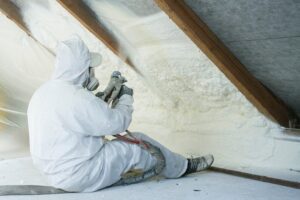Introduction
If you’re considering insulating your loft or adding to the existing insulation, you may have concerns about the possibility of damp issues. There have been reports of damp associated with wall cavity insulation, leading to worries about the potential for similar problems with loft insulation. In this comprehensive guide, we will debunk the myths surrounding loft insulation and damp, and provide you with practical solutions to avoid any potential issues.
Understanding the Relationship Between Loft Insulation and Damp
The primary purpose of loft insulation is to keep warm air within your property and prevent it from escaping through the roof. Loft insulation itself does not directly cause damp. However, it can contribute to dampness through condensation. Condensation occurs when warm, moisture-laden air comes into contact with cooler surfaces, causing the moisture to revert back to its liquid form.
Factors Contributing to Damp in the Loft
Several factors can exacerbate the issue of damp in the loft:
1. Insulation Gaps
When insulating the floor of your loft, it’s crucial to ensure that the insulation fully covers the area and provides a barrier against warm air from lower floors. However, the nature of insulation batts can result in gaps, especially around electrical outlets such as downlights. These gaps can allow warm, moisture-laden air to enter the loft, leading to condensation issues.
2. Roof Composition
The composition of your roof can also contribute to damp problems in the loft. Older homes often have bitumen felting as part of the roof structure, which does not allow for proper ventilation. As a result, warm air from downstairs cannot escape through the roof, leading to condensation buildup in the loft.
Preventing Damp in the Loft
To prevent damp issues in your loft, it’s essential to take proactive measures.
Here are some solutions to consider:
1. Ensure Adequate Airflow
Proper airflow is crucial to prevent condensation in the loft. If your loft is primarily used for storage, allowing for airflow through openings under the eaves and purpose-built gaps in the building can help circulate air. Installing Velux-type windows on the roof can also facilitate the release of warm air buildup.
2. Consider Spray Foam Insulation
Spray foam insulation offers a comprehensive solution to prevent damp in the loft. Unlike traditional insulation, spray foam expands to fill all gaps and forms a tight seal, preventing warm air from entering the loft and reducing temperature differences between the loft and the rest of the house. Spray foam insulation is particularly beneficial for loft rooms that require consistent temperature control, such as playrooms, studies, or bedrooms.
The Benefits of Spray Foam Insulation
Spray foam insulation offers several advantages over traditional insulation methods.
Here are some key benefits:
1. Improved Thermal Performance
Spray foam insulation provides enhanced thermal performance by creating a seamless barrier against heat loss. Its ability to fill gaps and cracks ensures maximum efficiency in preventing warm air from escaping.
2. Moisture Resistance
Unlike other insulation types, spray foam is not affected by moisture. Even if it becomes wet, spray foam remains effective in insulating and preventing the growth of mold and mildew.
3. Longevity
Spray foam insulation is long-lasting and requires minimal maintenance. Once applied, it remains stable and effective for many years, providing continuous energy savings.
4. Enhanced Structural Integrity
The structural integrity of your loft is crucial for the overall stability of your home. Spray foam insulation can help prevent rotting timber and structural issues by reducing the risk of condensation and dampness in the loft.
5. Versatility
Spray foam insulation can be applied to various areas, including the underside of the roof and the walls of the loft. This versatility allows for comprehensive insulation, ensuring a comfortable and energy-efficient living space.
Conclusion
In conclusion, loft insulation itself does not cause damp. However, it can contribute to dampness through condensation if proper precautions are not taken. By addressing insulation gaps, improving ventilation, and considering spray foam insulation, you can effectively prevent damp issues and create a comfortable, energy-efficient loft space. If you’re unsure about the best solution for your specific situation, consult with us at PTS Energy Solutions who are insulation experts who can provide personalized advice and guidance tailored to your home’s needs.
Remember, proactive measures and choosing the right insulation method are essential for maintaining a dry and comfortable loft environment. Don’t let the fear of damp deter you from reaping the energy-saving benefits of loft insulation. Take the necessary steps to ensure a well-insulated and damp-free loft space in your home, is done via a professional installer.
For more information or to discuss your specific insulation needs, contact our team of experts at PTS Energy Solutions. We’re here to help you create a comfortable and energy-efficient home.
PTS Energy Solutions offers a range of insulation services, including loft insulation, spray foam insulation, and cavity wall insulation. We pride ourselves on our industry expertise and commitment to providing high-quality solutions to homeowners. Our team of professionals is dedicated to ensuring customer satisfaction and delivering top-notch insulation services.

